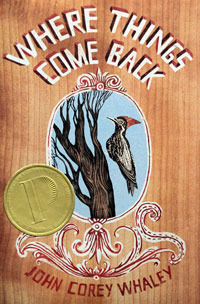 |
| Cover art by Grady McFerrin, image from goodreads.com |
Where Things Come Back, by John Corey Whaley, 2011
Whaley, John Corey. Where
Things Come Back. New York: Simon and Schuster, 2011. ISBN13: 9781442413337
Ages 14 and up
Being a teenager
growing up in small town Lily, Arkansas is boring. But when 17-year-old Cullen
Witter’s younger brother Gabriel goes missing, while the town is enthralled
with the prospect of possibly sighting a rare woodpecker, his summer takes
unexpected twists and turns. Meanwhile, Cabot Searcy, a college graduate who
cannot hold down a job due to his obsession with ancient, forbidden Biblical
texts, intersects with Cullen’s life in a sinister way.
First-time novelist
John Corey Whaley masterfully weaves two seemingly separate stories together to
create an intricate and fascinating young adult novel that touches upon many
struggles that teens may experience – sex and dating, bullying, friendship, death
and loss, uncertainty about the future, and dealing with parents.
Because there are
two separate stories that merge toward the end, the reader experiences
third-person narration in Cabot’s story, and Cullen narrates his own portion of
the story. Whaley captures Cullen’s teenage sense of cynicism, and does a
wonderful job of taking us inside his fantasies, where bullies become zombies,
and he and his friend Lucas are able to off them in video-game fashion. This is a fascinating book that will capture the attention of young men and young women alike.
Reading/writing connections:
- The author deals with several mature themes in this story, and it is written for a high school audience (14 and up). Have students write about how they deal with the problems in their lives. Do they create fantasy worlds where their problems are solvable in extraordinary ways? Do they isolate themselves from the world? Seek out the help and advice of friends? Have students write about a time when they had to deal with a serious problem, and how they handled it.
- Several times in the story, Cullen retreats into fantasies in his mind. Have students write about a fantasy they have had that solved a problem in their mind (such as winning the lottery to solve money problems – what would that be like?).
- Friendship is a theme that runs throughout Cullen's story. Have students write about a time when they helped a friend through hard times.
- The small town-ness of Lily, Arkansas is referenced many times in the book. Have students write about what they think small town life must be like, either from reading this book, from personal experience, or both.
- Michael L. Printz Award for Excellence in Young Adult Literature, 2012
- William C. Morris Debut Fiction Award, 2012
- Nominated for American Library Association's Best Fiction for Young Adults, 2012
Reviews:
“…explores the process of grief, second chances,
and even the meaning of life.” –Kirkus Reviews
“Because of how much
I enjoyed this book; because of the complexity of Cullen’s loss and grieving;
because I’ve reread the ending a half dozen times; and because I’ve been
searching for other reviews, looking for insights and analysis; this is a Favorite Book Read in 2011.” – School Library Journal
If you want to learn
more about author John Corey Whaley, here is a link to his website:
Here is a link to the
book’s official trailer:


